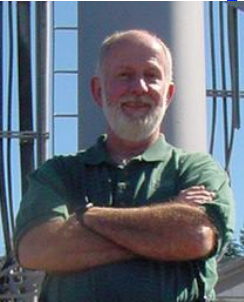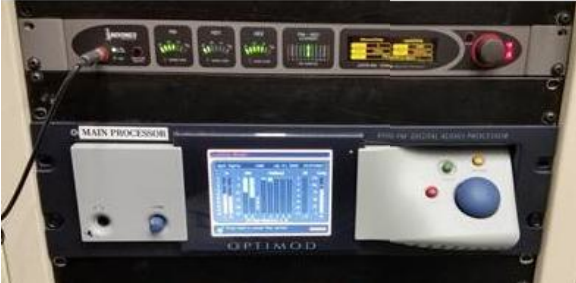The JUSTIN 808 Keeps HD in Sync

[March 2016] Getting the best out of a transmission system requires good test gear, careful attention, and using every available tool to improve the program chain. This includes HD stations, which bring some newer concerns ose stations using HD transmission have.
One of the first cities to embrace HD Radio was Seattle. Like San Francisco, the Seattle area is quite hilly and presents several challenges to the stations using digital signals.
Among those challenges are two that are especially important in Seattle: the timing differences between the analog and digital (HD-1) audio channels and the modulation levels of that audio.
Listening to many stations in the market as the receiver transitions from FM to HD (and back) really is not a pretty thing. Here in the Seattle area, with our varied topography, and geographically being spread into an area about 25 by 75 miles, the average mobile listener is going to experience many of these analog/digital transitions.
Who is in Charge?
It is the stations responsibility to do all they can to “get it right.”
Unfortunately, FM/HD1 timing was essentially a manual operation that needed to be periodically “tweaked.” There are stations using other equipment where there often are levels changes, as well as EQ changes.
These unexplained variations can appear to be a real ongoing problem, leading many listeners to conclude that this HD Radio thing is not perfected – or there is something wrong with their receiver and time to take it back to the vehicle dealer to get it fixed!
Nevertheless, even after the technical crew gets everything setup just right, many HD users have found the Exporter or other equipment in the chain did not provide stable timing synchronization between the digital and analog.
For some, this required frequent trips to the transmitter to adjust the timing.
Transmitter Site Upgrade
KING-FM, one of my clients in Seattle, had just installed a new Nautel GV30 transmitter for the primary purpose of increasing their HD power levels (they are operating with HD sidebands of -10 and -14 dBc).
The goal was increased HD coverage, including better building penetration, for their three different streams of Classical Music (HD 1, 2 & 3), and a desire to fine-tune the listening experience for the mobile listener by making the transition from Analog (FM) to HD-1 as seamless as possible.
Originally, setting the time alignment was the total responsibility of their primary audio processor, an Orban 8500 HD. Because KING-FM did not have a means of observing the timing – and adjusting by ear (especially with a Classic Music format) is problematic at best – I would call a friend at another station. At least any needed corrections could be made anywhere, as the 8500 was connected to the station’s LAN.
My friend would observe the timing on either an Audemat or Belar monitor that would display the parameter and I would make the adjustment accordingly. While it mostly worked, overall, it was not really the best way to accomplish the task.
The JUSTIN 808
Thanks to our generally stable equipment adjustment was not needed very often to keep the timing within the range where a listener might notice it. But it did require attention lest it get far enough to annoy listeners – and station personnel.
Advertising for the JUSTIN 808 appeared to point to a simple – and automatic – solution to the timing issue. I worked with the Operations Manager of the station (Mike Brooks) on the purchase and set up. We had a couple of reasons for choosing the JUSTIN 808:
- It is a “stand-alone” device not requiring an interconnection to another device.
- The reputation of Inovonics for turning out good/reliable equipment.
- The Inovonics “attitude” when you contact them asking for help – In a word: “Wonderful.”

KING-FM’s JUSTIN 808 is fed by an Orban 8500
Quick, Easy Installation
Installation of the JUSTIN 808 is easy, once you understand that on an FM Station operating HD, you must delay the FM Audio by some amount. This is conventionally accomplished in the station’s Exporter or audio processor (usually about 8 seconds).
In the KING-FM installation the only new cabling required was an XLR connector cable to connect the JUSTIN 808 in series with the audio processor and a short piece of RG58/59 to connect the input to a sample on the output line.
Here is a simple explanation of what goes on:
- The Justin 808 needs a receive antenna. I elected to connect the receiver input to an FM sample on the station’s transmission line.
- You insert the JUSTIN 808 in series in the delayed audio path and increase the amount of delay you already had.
- The JUSTIN 808’s receiver listens to your stations FM and HD and automatically adjusts the amount of delay to obtain perfect time alignment.
Minor Hiccup
Initially I did have some issues with the receive antenna producing conditions that would cause the unit to produce the wrong alignment.
Actually, I should note that the receiver is quite good; a simple twin-lead dipole enabled it to hear the KING-FM Aux Transmitter several miles away. However there also was congestion produced by the 12 other stations that populate West Tiger Mountain. Personally, I think Inovonics should recommend connecting the Justin 808’s input to the station’s transmitter output in congested RF environments.
I can understand why they suggest an antenna as most stations are not at large combined sites and/or may have their equipment configured differently, such as when the JUSTIN 808 might be installed at the studio etc.
Operation
Generally it will take a few minutes from a cold start. The JUSTIN 808 will, in a short period, measure the amount of timing changes necessary and implement them automatically. Or, if you prefer, you can command it to make the change quickly. This video shows the process.
The front panel tells you the whole story about what going on.

Depending upon your installation you may see its corrective action taking place. Remember that once installed, you just walk away.
The unit can be monitored by IP, and I should mention that the IP interface will provide you with a good deal more information than does the front panel. In the case of KING-FM, I will, on occasion, notice the JUSTIN 808 going to work on a timing issue – reassuring me that it is doing its job, and I do not have to.
Overall, I have found monitoring the JUSTIN 808 is not required. Let me put it this way: now the FM/HD1 levels are never off – ever. You install it, it does the job from that point forward and you forget it.
Almost Boring
Now we all just sit back knowing that our time alignment problems have been taken care of automatically. It is almost boring to watch.
I can honestly say their advertising for this product was spot-on. It works as advertised which is something that does not happen every day.
At the same time, although installation was, as mentioned, pretty straight-forward, occasionally a question came up. As mentioned, Tech support from Inovonics was wonderful – quick and knowledgeable.
Bottom Line
I would be pleased to recommend the JUSTIN 808 to others. The fact that it simply works and does so without requiring any intervention is the best one.
In the year since, we have been thrilled with the operation of the JUSTIN 808. It has solved the HD issues in a way that presents a completely solid HD audio signal to listeners.
Unfortunately too many FM stations fail to grasp that they are very much in control of the HD Radio experience.
With all of the new vehicles coming out with HD Radio built-in – I find it harder and harder to understand why broadcasters are dragging their feet on increasing HD power levels as well as improving time-alignment.
No one wants a station that is deemed to be an under-performer in the minds of the listeners. You want listeners to “save” your station as a preset on their radio. They will not do that if the differences between your FM and HD products are irritating.
In short: The time for excuses is over – the right tools are available now at your favorite dealer.
– – –
For more information, click here.
A frequent contributor to The BDR, Clay Freinwald, is a veteran Seattle market engineer who continues to serve clients from standalone stations to multi-station sites.
You can contact Clay at K7CR@blarg.net
– – –
Are articles like this helpful to you? If so, you are invited to sign up for the one-time-a-week.BDR Newsletter.
It takes only 30 seconds by clicking here.
– – –
